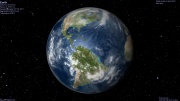Planetary Database/Terran/Earth
m |
m |
||
| Line 26: | Line 26: | ||
The geologic component layers of the Earth are located at the following depths below surface: | The geologic component layers of the Earth are located at the following depths below surface: | ||
| − | + | * 0 to 60 km - Lithosphere (locally varies between 5 and 200 km) | |
| − | + | o 0 to 35 km - Crust (locally varies between 5 and 70 km) | |
| − | + | o 35 to 60 km - Uppermost part of mantle | |
| − | + | * 35 to 2890 km - Mantle | |
| − | + | o 100 to 700 km - Asthenosphere | |
| − | + | * 2890 to 5100 km - Outer core | |
| − | + | * 5100 to 6378 km - Inner core | |
== Terrain == | == Terrain == | ||
| Line 38: | Line 38: | ||
Elevation extremes: (measured relative to sea level) | Elevation extremes: (measured relative to sea level) | ||
| − | + | * Lowest point on land: Dead Sea −417 m | |
| − | + | * Lowest point overall: Mariana Trench in the Pacific Ocean −10,924 m [1] | |
| − | + | * Highest point: Mount Everest 8,844 m (2005 est.) | |
Revision as of 19:23, 8 April 2006
The Planetary Database - Terran System - Earth
Earth is a Class-M and third planet of the Terran Solar System, the homeworld of humanity and the location of the office of the President of the United Federation of Planets.
Lexicography
Terms that refer to the Earth can use the Latin root terra-, such as the word terrestrial. There is also the alternative Latin root tellur-, as used in words such as telluric, tellurian, tellurion and Tellurium, which derives the goddess Terra Mater's more ancient name Tellūs Mater. Scientific terms such as geography, geocentric and geothermal use the Greek prefix geo-, derived from Terra Mater's Greek counterpart Gaia.
The English word "earth" has cognates in many modern and ancient languages. Examples in modern tongues include aarde in Dutch and Erde in German. The root also has cognates in extinct languages such as ertha in Old Saxon and ert (meaning "ground") in Middle Irish, derived from the Old English eorðe. All these words are derived from the Proto-Indo-European base *er-. Given metathesis, we can find cognates of "earth" between terra and the modern Romance languages, for instance tierra in Spanish or terra in Portuguese.
History
Based on the available evidence, scientists have been able to reconstruct detailed information about the planet's past. Earth is believed to have formed around 4.5 Billion years ago out of the solar nebula, along with the Sun and other planets. The moon formed soon afterwards. Initially molten, the outer layer of the planet cooled, resulting in the solid crust. Outgassing and volcanic activity produced the primordial atmosphere; condensing water vapor, augmented by ice delivered by comets, produced the oceans. The highly energetic chemistry is believed to have produced a self-replicating molecule around 4×109 years ago, and half a billion years later, the last common ancestor of all life lived. The development of photosynthesis allowed the sun's energy to be harvested directly; the resultant oxygen accumulated in the atmosphere and gave rise to the ozone layer. The incorporation of smaller cells within larger ones resulted in the development of complex cells called eukaryotes.
Cells within colonies became increasingly specialized, resulting in true multicellular organisms. With the ozone layer absorbing harmful ultraviolet radiation, life colonized the surface of Earth. Over hundreds of millions of years, continents formed and broke up as the surface of Earth continually reshaped itself. Since the Cambrian explosion, about 535 million years ago, there were 5 distinct mass extinctions. The last one occurred 65 million years ago, when a meteorite collision probably triggered the extinction of the (non-avian) dinosaurs and other large reptiles, but spared small animals such as mammals, which then resembled shrews. Over the last 65 million years, mammalian life diversified, and several million years ago, a small African ape gained the ability to stand upright. As brain size increased, these hominids developed the use of tools and language.
The development of agriculture, and then civilization allowed humans to affect the Earth in a short timespan like no other life form had before, affecting both the nature and quantity of other life forms as well as global climate.
Composition
The geologic component layers of the Earth are located at the following depths below surface:
* 0 to 60 km - Lithosphere (locally varies between 5 and 200 km) o 0 to 35 km - Crust (locally varies between 5 and 70 km) o 35 to 60 km - Uppermost part of mantle * 35 to 2890 km - Mantle o 100 to 700 km - Asthenosphere * 2890 to 5100 km - Outer core * 5100 to 6378 km - Inner core
Terrain
Elevation extremes: (measured relative to sea level)
- Lowest point on land: Dead Sea −417 m
- Lowest point overall: Mariana Trench in the Pacific Ocean −10,924 m [1]
- Highest point: Mount Everest 8,844 m (2005 est.)
